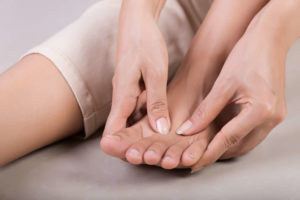How a Podiatrist Can Help with Morton’s Neuroma
 Morton’s neuroma is a fairly common condition that affects the ball of the foot and the toes. People with the condition may experience pain and discomfort and difficulty walking. For some people, the condition can lead to chronic pain that makes it very difficult to bear any weight on their foot at all. However, there are also some people with Morton’s neuroma that do not experience any symptoms. Let’s look at what a Morton’s neuroma is, the symptoms and what you can do about it.
Morton’s neuroma is a fairly common condition that affects the ball of the foot and the toes. People with the condition may experience pain and discomfort and difficulty walking. For some people, the condition can lead to chronic pain that makes it very difficult to bear any weight on their foot at all. However, there are also some people with Morton’s neuroma that do not experience any symptoms. Let’s look at what a Morton’s neuroma is, the symptoms and what you can do about it.
What is Morton’s neuroma?
Morton’s neuroma refers to a thickening of the tissue around the small nerves leading to the toes. Morton’s neuroma most typically affects the area between the third and fourth toes. Despite the name, the condition is not a true ‘neuroma’, which is a benign tissue tumour. It is a fibrosis of the nerve–meaning excess connective tissue growth.
Who gets Morton’s neuroma and why?
The thickening of tissue is thought to occur in response to repetitive load over time, injury or trauma to the foot, or changes in blood supply. Certain sports can increase the risk of Morton’s neuroma, especially if they involve putting pressure on the ball of the foot. Examples include running, tennis and squash. Wearing pointy-toed or high-heeled shoes can also be a factor, due to increased pressure over the forefoot.A person’s foot structure or anatomy, for example flat feet or high arches, may predispose them to experiencing symptoms of Morton’s neuroma.According to the American Academy of Orthopaedic Surgeons, the condition is about eight times more common in women than men – especially women between the ages of 30 and 60.
What are the symptoms of Morton’s neuroma?
While not all people with the condition experience symptoms, common complaints include a stabbing or burning pain in the foot, and the feeling of having a stone in the shoe with weight-bearing movements such as walking. Some people also report tingling or numbness in the corresponding toes, and/or a clicking sensation in the forefoot. The discomfort from Morton’s neuroma can increase with walking and wearing tight or heeled shoes, and be relieved by removing shoes and resting the feet. However, in chronic cases, the pain may be persistent. Severe symptoms can interfere with a person’s mobility and capacity to participate in everyday activities.
How is Morton’s neuroma diagnosed and treated?
In the majority of cases, Morton’s neuroma is diagnosed by taking a comprehensive history and doing a physical examination, such as checking for tenderness in the affected area. Occasionally, your podiatrist may suggest you have an ultrasound to confirm the diagnosis or rule out other conditions such as fracture, arthritis, tarsal tunnel syndrome, hammer toe and bursitis. The aim of treatment is not always to ‘fix’ the foot, but to improve function and minimise pain.
Non-surgical treatment options include:
- Wearing appropriate footwear – such as wide-toed laced shoes with a low heel to relieve pressure on the nerve.
- Manual therapy to relieve symptoms.
- Activity modification – changing how you do things to relieve the pressure on your foot until the condition improves.
- Use of ice-packs – to relieve pain and swelling.
- Orthotics – specially designed insoles or pads to relieve pressure on the affected area.
Other non-surgical options include:
- Cryotherapy, also called cryosurgery– this is cold temperature therapy that freezes the neuroma using a thin probe while leaving parts of the nerve intact. This method prevents the numbness and the scar tissue formation that can result from invasive surgery.
- Injections – alcohol and corticosteroid injections may help relieve pain and inflammation. However, the relief is not always permanent.
In rare cases, surgery might be called for. Surgery for Morton’s neuroma involves removing a piece of the affected nerve tissue. However, some patients report increased pain after surgery, which can be due to the growth of scar tissue or a ‘stump neuroma’.
Reducing the risk of Morton’s neuroma
Prevention may involve wearing well-fitted, comfortable shoes, avoiding wearing high-heeled or tight shoes for long periods, wearing well-cushioned shoes while active, and discussing your sporting techniques with your coach or trainer. Maintaining a healthy weight can reduce pressure on the feet, so this may be another consideration. A qualified podiatrist can help by discussing and analysing your case and providing treatments tailored to your condition. Please contact us to book an appointment.
Sources:
[1] https://www.ncbi.nlm.nih.gov/books/NBK470249/
[2] https://www.ncbi.nlm.nih.gov/pmc/articles/PMC8277559/
[3] https://www.ncbi.nlm.nih.gov/pmc/articles/PMC7211826/
[4] https://my.clevelandclinic.org/health/diseases/15118-mortons-neuroma
[5] https://orthoinfo.aaos.org/en/diseases–conditions/mortons-neuroma

